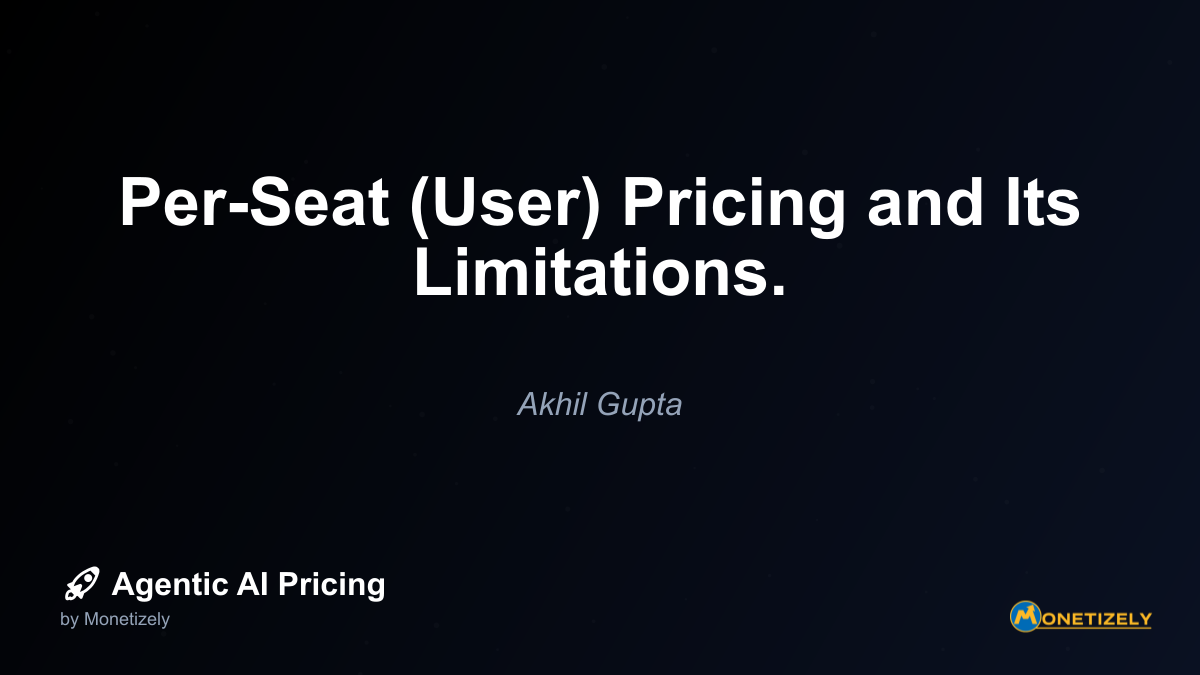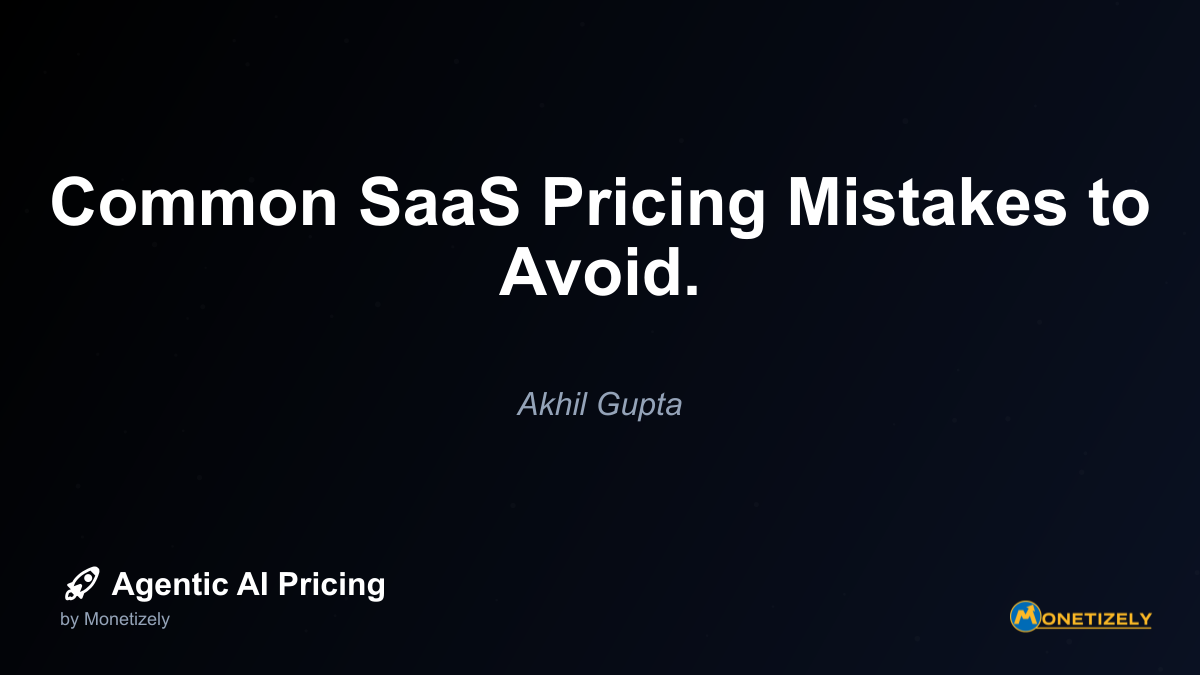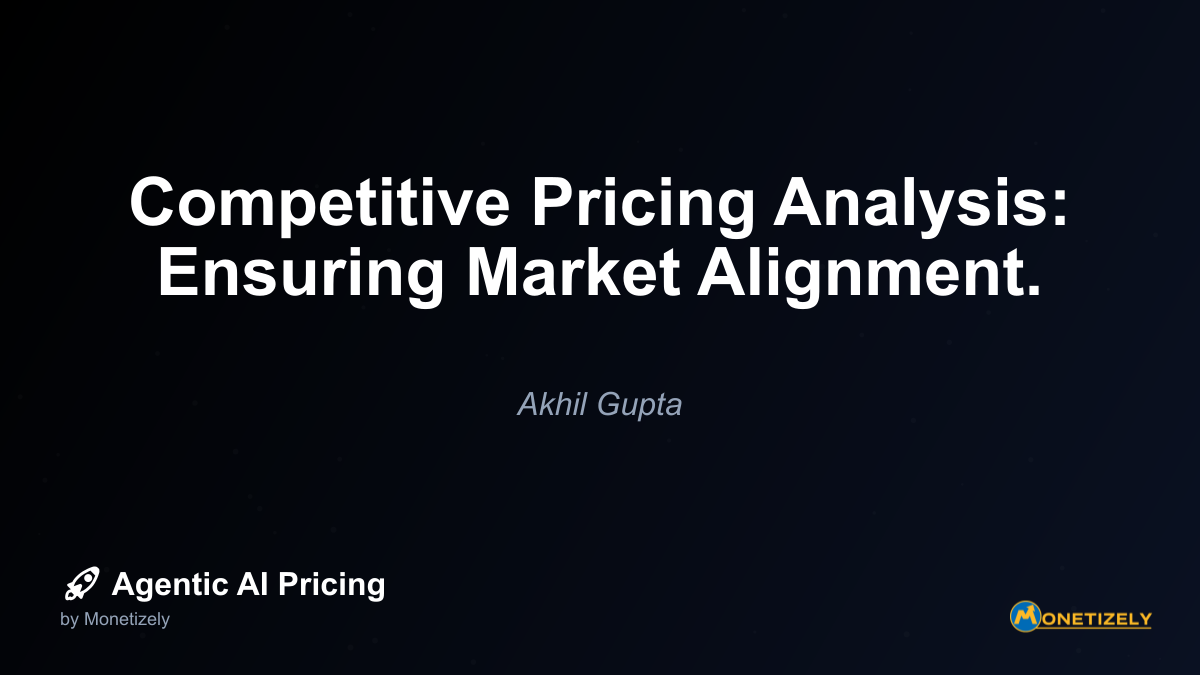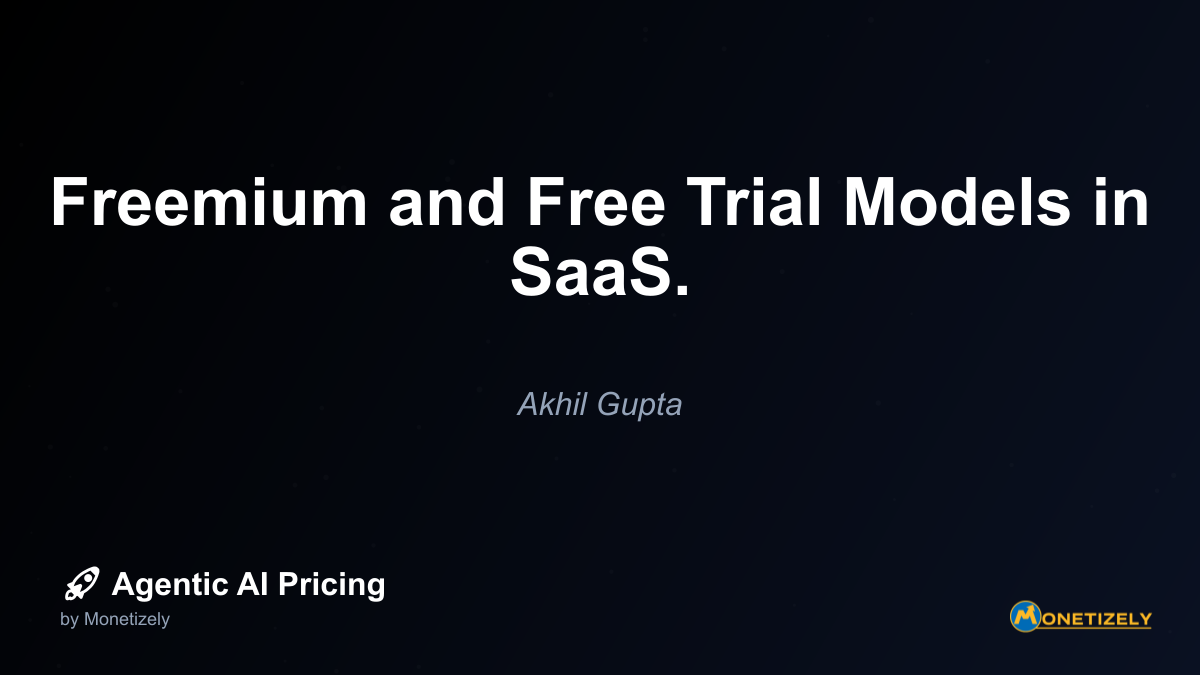· Akhil Gupta · Pricing Fundamentals · 10 min read
Per-Seat (User) Pricing and Its Limitations.
AI and SaaS Pricing Masterclass
Learn the art of strategic pricing directly from industry experts. Our comprehensive course provides frameworks and methodologies for optimizing your pricing strategy in the evolving AI landscape. Earn a professional certification that can be imported directly to your LinkedIn profile.

The traditional per-seat pricing model has been a cornerstone of SaaS and enterprise software for decades. It’s straightforward, predictable, and easy to understand: each user who accesses your software pays a fixed fee. But as artificial intelligence reshapes the productivity landscape, this familiar pricing approach faces unprecedented challenges. When a single AI agent can perform tasks that once required multiple human users, the fundamental value equation changes dramatically.
The Evolution of Per-Seat Pricing
Per-seat pricing (also called user-based licensing) emerged as software transitioned from physical products to digital services. The logic was compelling: each person using the software represented a distinct unit of value consumption. Organizations paid based on headcount, creating a direct correlation between company size, usage, and pricing.
In its most basic form, per-seat pricing charges a fixed amount per user per month or year. For example:
- Basic plan: $10/user/month
- Professional plan: $25/user/month
- Enterprise plan: $50/user/month
This model gained popularity because it aligned well with how businesses operated. As companies grew and hired more employees, they naturally required more software licenses. The pricing scaled with the organization’s expansion, creating predictable revenue for vendors and manageable costs for customers.
Why Per-Seat Pricing Worked Well Historically
Several factors made per-seat pricing the dominant model for software:
1. Clear Value Attribution
Each user license represented a discrete unit of value. When every employee needed their own login to access and benefit from the software, counting users provided a reasonable proxy for value delivered.
2. Simplicity and Transparency
Both vendors and customers could easily understand the pricing structure. Forecasting costs became straightforward—simply multiply the per-seat price by the number of required users.
3. Predictable Revenue Growth
Software companies could forecast revenue based on customer growth patterns. As client organizations expanded their workforce, license revenue grew proportionally.
4. Natural Expansion Mechanism
Per-seat pricing created built-in expansion revenue. As customers added employees, they needed additional licenses, driving organic revenue growth without requiring new customer acquisition.
5. Alignment with Budgeting Processes
Organizations typically budget by department and headcount, making per-seat pricing easy to incorporate into existing financial planning.
The Traditional Per-Seat Pricing Structure
Most per-seat pricing models incorporate several common elements:
Tiered Pricing: Different feature sets at various price points allow customers to select the appropriate level for different user types.
Volume Discounts: Larger organizations typically receive discounted per-seat rates, acknowledging both the economies of scale and the increased negotiating leverage of bigger customers.
Annual Commitments: Many vendors offer discounts for annual versus monthly payment commitments, improving cash flow and reducing churn.
Role-Based Differentiation: Some models charge different rates based on user roles—administrators or power users may cost more than basic users with limited access.
Minimum Seat Requirements: To ensure baseline revenue, vendors often establish minimum seat purchases, particularly for higher-tier plans.
The Agentic AI Challenge to Per-Seat Pricing
The emergence of agentic AI—autonomous AI systems that can perform complex tasks with minimal human intervention—fundamentally disrupts the correlation between user count and value delivered.
The Productivity Multiplier Effect
When one AI agent can replace the productivity of multiple human users, the traditional pricing model breaks down. Consider these scenarios:
Customer Support: A single customer support representative using an AI agent might handle the workload previously requiring five representatives. Under traditional per-seat pricing, the software vendor receives 80% less revenue despite delivering the same or greater value.
Data Analysis: An analyst with AI tools might perform analysis that previously required a team of specialists. The value delivered increases dramatically while the seat count decreases.
Content Creation: A marketing team might deploy AI agents that generate content equivalent to what previously required numerous copywriters. The value scales while user count remains static or decreases.
The Decoupling of Usage and User Count
Agentic AI creates a fundamental disconnect between the number of human users accessing a system and the actual usage or value derived from that system.
A small team armed with powerful AI agents might generate thousands of outputs, consume substantial computing resources, and derive enormous value—all while maintaining a minimal user footprint. This creates a mismatch between the value delivered and the revenue captured through traditional per-seat pricing.
Five Key Limitations of Per-Seat Pricing for AI Services
1. Value Capture Failure
The most fundamental limitation is the inability to capture a fair share of the value created. When one user with AI assistance can produce the output of multiple people, charging only for that single user leaves significant value uncaptured.
For example, if a legal AI tool allows one paralegal to perform document review that previously required ten people, charging only for one seat fails to reflect the 10x productivity gain the customer receives.
2. Misaligned Incentives
Per-seat pricing can create perverse incentives that work against both the vendor and customer. Customers are motivated to limit seat counts and maximize usage per seat, potentially leading to:
- Account sharing (multiple people using one login)
- Overloading individual users with tasks
- Resistance to broader adoption within the organization
- Consolidated usage patterns that may impact system performance
Meanwhile, vendors are incentivized to restrict features that enable collaboration or delegation to AI agents, as these would reduce the need for additional seats.
3. Unpredictable Scaling Economics
AI services often have different cost structures than traditional software. While traditional SaaS may have minimal marginal costs per additional user, AI services frequently incur significant computing costs based on usage intensity rather than user count.
A single power user might consume exponentially more resources than dozens of casual users. Per-seat pricing fails to account for these varying consumption patterns, potentially leading to unsustainable economics for the vendor.
4. Innovation Penalty
Perhaps most problematically, per-seat pricing can actually penalize vendors for creating more powerful AI capabilities. As the AI becomes more capable of handling tasks autonomously, customers need fewer human operators—directly reducing the vendor’s revenue under a per-seat model.
This creates a counterproductive dynamic where improving the product’s capabilities may actually decrease revenue potential.
5. Competitive Vulnerability
Companies using per-seat pricing for AI services become vulnerable to competitors using more sophisticated pricing models. A competitor using usage-based or value-based pricing can potentially offer more compelling economics to customers while better capturing the value they deliver.
Real-World Examples of Per-Seat Limitations
Case Study: Enterprise Workflow Automation
Consider an enterprise workflow automation platform that initially charged $50 per user monthly. The platform added increasingly sophisticated AI capabilities that could automate complex approval chains and decision processes.
Result: As customers deployed these capabilities, they found they needed fewer administrators to manage the same workflows. Some enterprise customers saw 70% reductions in required seats, significantly reducing the vendor’s revenue despite delivering more value.
The company eventually shifted to a hybrid model charging a base platform fee plus scaled pricing based on workflow volume and complexity.
Case Study: AI-Enhanced CRM
A CRM vendor priced solely on per-seat licensing added AI capabilities that could automatically qualify leads, recommend next actions, and even conduct initial outreach.
Result: Sales teams found they could handle larger territories with fewer people. The average team size decreased by 30%, directly impacting the vendor’s revenue. Meanwhile, implementation costs increased due to the computing resources required for the AI features.
The vendor ultimately moved to a model that included both per-seat components and usage-based pricing for AI features.
Case Study: Legal Document Analysis
A legal tech platform initially charged law firms per attorney using their document analysis system. After adding advanced AI capabilities that could review thousands of documents with minimal human supervision, they faced a revenue crisis.
Result: Law firms dramatically reduced the number of licensed users while processing more documents than ever. The disconnect between value delivered and revenue received became untenable.
The company pivoted to a model based primarily on document volume with additional charges for specialized AI processing features.
When Per-Seat Pricing Still Makes Sense for AI Services
Despite these limitations, per-seat pricing isn’t obsolete. It remains appropriate in specific AI contexts:
1. Personal Productivity Enhancement
When AI primarily augments individual productivity without fundamentally changing the number of people needed for a function, per-seat pricing may remain viable. Personal assistant AI tools often fall into this category.
2. Regulatory or Compliance Requirements
In industries with strict regulatory requirements for individual accountability and audit trails, per-seat licensing may remain necessary regardless of AI capabilities.
3. Early Market Education
In early-stage markets where customers are unfamiliar with AI capabilities, starting with familiar per-seat pricing can ease adoption before transitioning to more sophisticated models.
4. Hybrid Human-AI Workflows
When the AI requires significant human oversight or validation, the correlation between users and value may remain intact enough to justify per-seat components in the pricing model.
Alternative Pricing Approaches for Agentic AI
As organizations recognize the limitations of traditional per-seat pricing for AI services, several alternative models have emerged:
Usage-Based Pricing
Charging based on actual consumption metrics like:
- API calls or requests
- Compute time
- Data processed
- Outputs generated
This approach aligns revenue more directly with the resources consumed and value delivered.
Outcome-Based Pricing
Tying pricing to measurable business outcomes such as:
- Revenue generated
- Cost savings achieved
- Productivity gains
- Error reduction
This approach directly links pricing to the value created, though it can be more complex to implement.
Hybrid Models
Many successful AI pricing strategies combine multiple approaches:
- Base platform fee + per-seat components for human users
- Core subscription + usage-based components for AI interactions
- Tiered usage bundles with overage charges
These models provide predictability while better capturing value from intensive AI usage.
Value-Based Pricing
Some advanced AI providers are moving toward sophisticated value-based pricing that considers:
- The economic value of tasks being automated
- The strategic importance of the application
- The competitive alternatives available
- The customer’s ability to capture and measure value
Transitioning Away From Pure Per-Seat Pricing
For organizations currently using per-seat pricing for AI services, transitioning to a new model requires careful planning:
1. Analyze Usage Patterns
Before making any changes, thoroughly analyze how customers currently use your AI service:
- Who are the power users?
- What usage patterns correlate with customer success?
- How does value creation relate to user count?
2. Model Economic Impacts
Create detailed financial models showing how different pricing approaches would affect:
- Overall revenue
- Customer economics
- Margins and profitability
- Customer acquisition costs
3. Segment Your Customer Base
Different customer segments may require different approaches:
- Enterprise customers might prefer predictable pricing with negotiated caps
- SMBs might prefer pay-as-you-go models with low entry points
- Startups might need special considerations to encourage adoption
4. Develop a Transition Strategy
Most successful pricing transitions include:
- Grandfathering existing customers temporarily
- Creating incentives for voluntary migration
- Clear communication about the rationale for changes
- Demonstrating the value alignment of the new model
5. Test Before Full Deployment
Consider running pilot programs with select customers to:
- Validate the new pricing structure
- Identify potential issues
- Gather testimonials for broader rollout
- Refine messaging and positioning
Conclusion
Per-seat pricing served the software industry well for decades, but the emergence of agentic AI requires a fundamental rethinking of this approach. When one AI-empowered user can perform the work of many, pricing based solely on user count fails to capture the true value delivered.
The most successful AI providers are moving toward more sophisticated pricing models that better align with the unique value dynamics of artificial intelligence. These approaches recognize that in the age of AI, the relationship between human users and value creation has fundamentally changed.
Organizations that cling to traditional per-seat pricing for AI services risk leaving significant revenue on the table while creating misaligned incentives with their customers. Those that thoughtfully evolve their pricing strategies to reflect the new reality of AI-driven productivity will be better positioned to capture their fair share of the tremendous value they create.
The transition may be challenging, but the economics of agentic AI make it inevitable. The question isn’t whether to move beyond per-seat pricing, but how and when to make the transition in a way that maintains customer relationships while properly valuing the transformative capabilities that AI brings to the table.
Co-Founder & COO
Akhil is an Engineering leader with over 16+ years of experience in building, managing and scaling web-scale, high throughput enterprise applications and teams. He has worked with and led technology teams at FabAlley, BuildSupply and Healthians. He is a graduate from Delhi College of Engineering and UC Berkeley certified CTO.
Pricing Strategy Audit
Let our experts analyze your current pricing strategy and identify opportunities for improvement. Our data-driven assessment will help you unlock untapped revenue potential and optimize your AI pricing approach.




